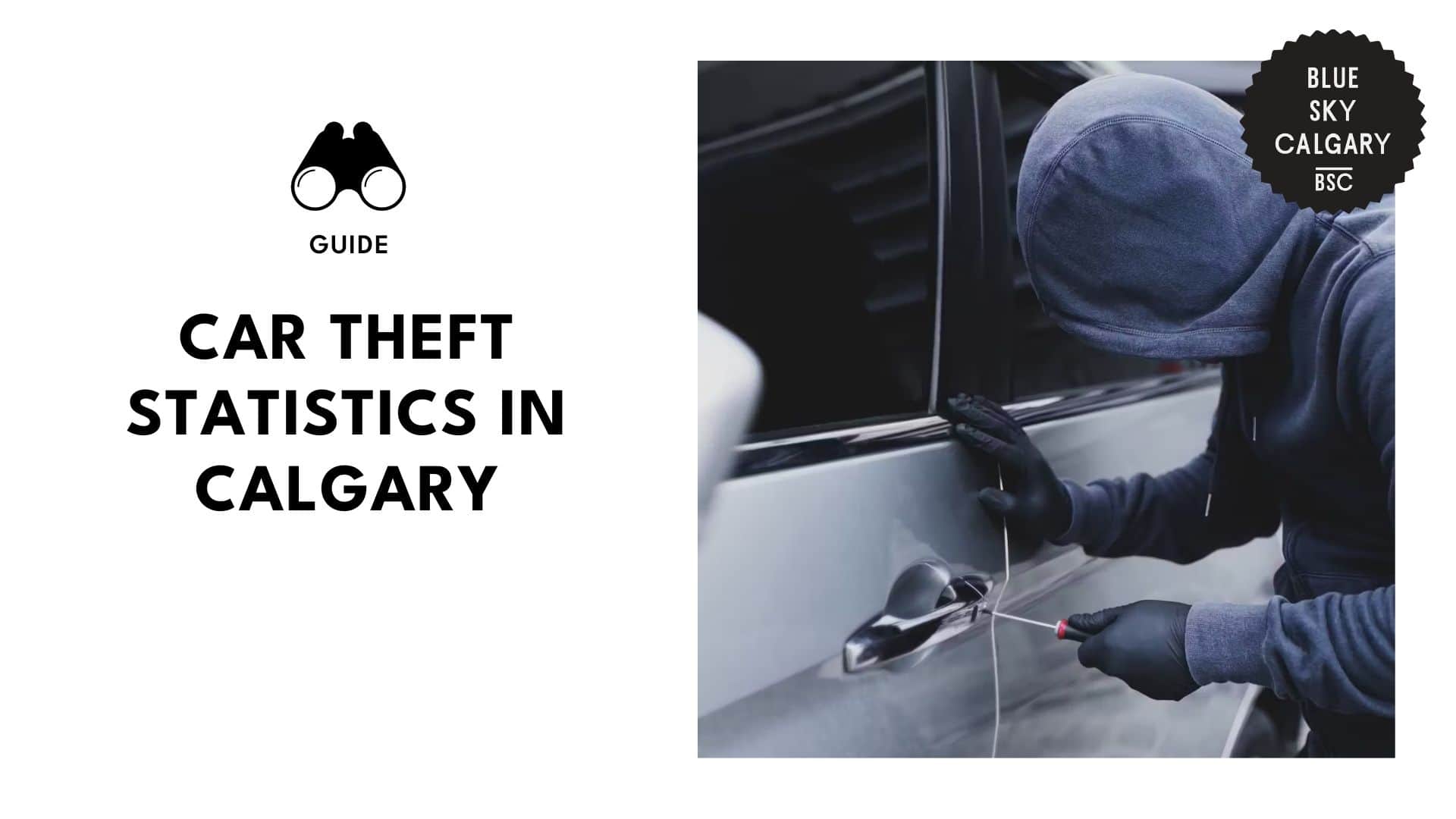Rising Car Theft in Calgary: Statistics, Insurance Costs, and Future Risks
Key Insights
| Data from CTV News shows that Alberta currently holds the highest rate of auto theft per capita in Canada, though the vehicle recovery rate in the province decreased from 87% in 2022 to 77% in 2024. Statistics by the Equite Association Canada show that SUVs lead the most stolen vehicles, and the most stolen vehicle of 2023 is the 2021 model Toyota Highlander. As per Statistics Canada, Alberta maintains one of the country’s highest rates of auto theft, with 411 occurrences for every 100,000 people in 2023. The Insurance Bureau of Canada depicts how, between 2021 and 2023, Calgary’s auto theft claims increased from $20.86 million to $33.08 million, which is a 59% growth over two years. In a separate report, they also show how auto theft has resulted in immense financial losses, as private auto insurers in Canada paid out $1.5 billion in theft claims in 2023 alone. |
CTV News reports that auto theft in Alberta has emerged as an escalating issue, with the province now having the highest per capita rate of auto theft in Canada.
This trend has placed a growing financial burden on vehicle owners and insurers as theft-related claims continue to rise across the province.
Currently, the vehicle recovery rate in the province has decreased from 87% in 2022 to 77% in 2024, which is an indication of the difficulties presented by new theft methods, such as overseas smuggling and fraudulent re-registering.
Thieves are increasingly targeting newer, more expensive vehicles for export while also taking advantage of registration loopholes to make it more difficult to detect stolen vehicles.
Based on data from the Équité Association, Alberta has also experienced an increase in instances of re-VINing, which are stolen vehicles being registered with fake vehicle identification numbers, hence complicating recovery efforts.
| Year | Vehicle Recovery Rate |
| 2022 | 87% |
| 2023 | 85% |
| 2024 | 77% |
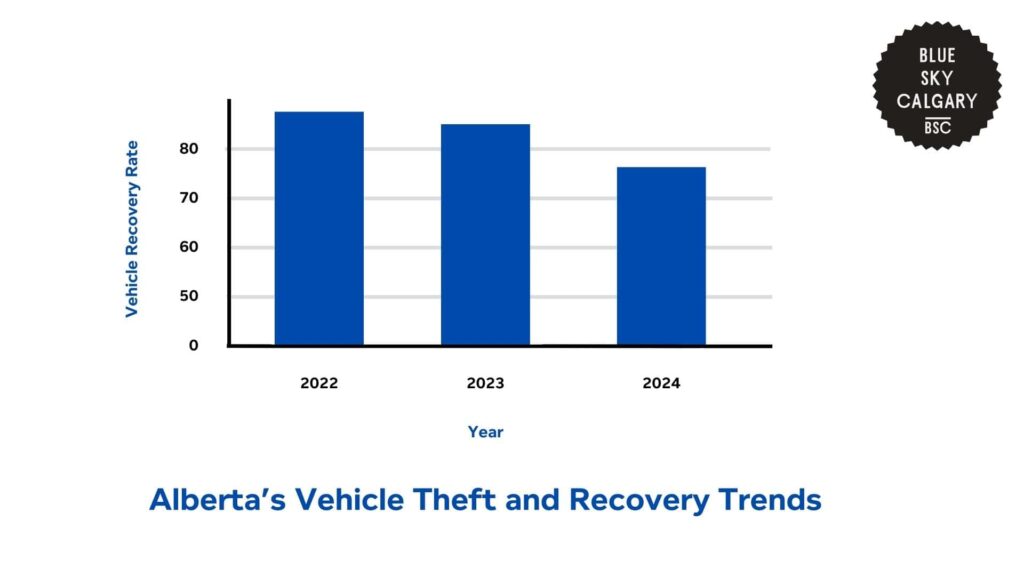
Top 10 Most Stolen Vehicle Models in Canada
Data from the Equite Association Canada reveals that SUVs dominate the list of most stolen vehicles, with the Toyota Highlander (2021 model) ranking as the most frequently stolen vehicle in 2023.
Other frequently stolen SUVs include the Lexus RX Series (2022 model), which was stolen 3,037 times, the Honda CR-V (2021 model), stolen 2,988 times, and the Toyota RAV4 (2021 model), stolen 2,690 times.
These numbers reflect the attraction of thieves for newer SUVs, especially with high resale values and extensive supplies in the market.
| Rank | Make/Model | Most Stolen Model Year | # of Vehicles Insured | # of Thefts | Theft Rate (%) | Type |
| 1 | Toyota Highlander | 2021 | 123,532 | 3,414 | 2.76% | SUV |
| 2 | Dodge Ram 1500 Series | 2022 | 524,837 | 3,078 | 0.59% | Truck |
| 3 | Lexus RX Series | 2022 | 96,400 | 3,037 | 3.15% | SUV |
| 4 | Honda CR-V | 2021 | 487,962 | 2,988 | 0.61% | SUV |
| 5 | Toyota RAV4 | 2021 | 507,451 | 2,690 | 0.53% | SUV |
| 6 | Honda Civic | 2019 | 697,143 | 1,654 | 0.24% | Car |
| 7 | Jeep Wrangler | 2021 | 141,379 | 1,641 | 1.16% | SUV |
| 8 | Land Rover Range Rover Series | 2020 | 34,615 | 1,533 | 4.43% | SUV |
| 9 | Chevrolet/GMC Suburban/Yukon/Tahoe Series | 2023 | 62,877 | 1,488 | 2.37% | SUV |
| 10 | Chevrolet/GMC Silverado/Sierra 1500 Series | 2006 | 595,765 | 1,383 | 0.23% | Truck |
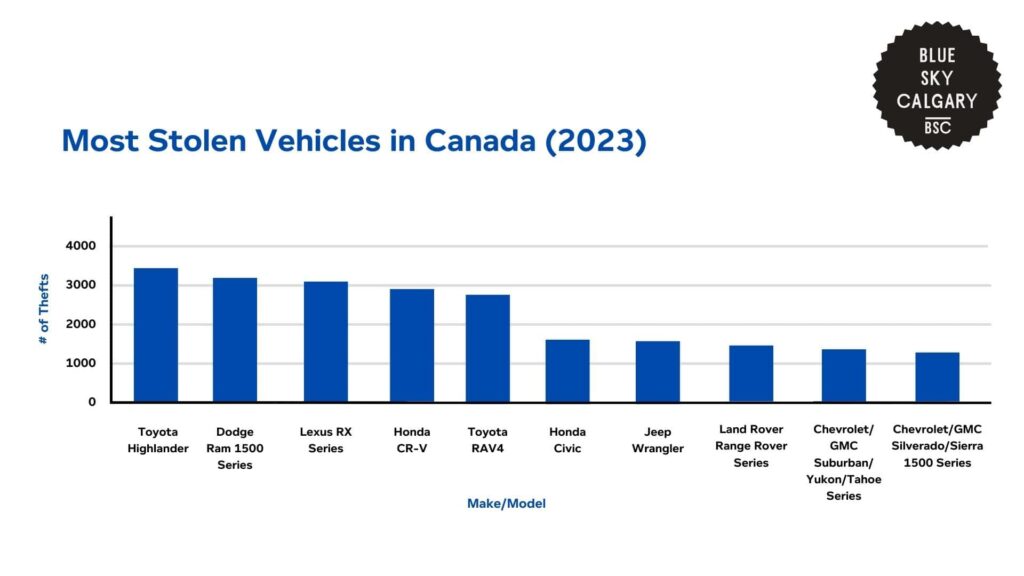
Trucks are also heavily represented among the top stolen vehicles, with the Dodge Ram 1500 Series (2022 model) at number two with 3,078 thefts.
The Chevrolet/GMC Silverado and Sierra 1500 Series (2006 model) also appear on the list, with 1,383 thefts.
Even though this model is much older than other widely stolen vehicles, its presence on the list indicates that some trucks are still targeted, perhaps for parts resale or re-registration with fake VINs.
Luxury SUVs registered some of the highest theft rates, even though they had fewer insured vehicles overall. The 2020 Land Rover Range Rover had a 4.43% theft rate, the highest among all cars in the database.
Meanwhile, the 2022 Lexus RX Series had a 3.15% theft rate, highlighting the popularity of luxury SUVs among thieves.
By contrast, the Honda Civic (2019 model), being one of only a few non-SUVs on the list, posted a much lower rate of theft of 0.24%, although it is a very common car with 697,143 insured units.
Overall, throughout Canada, the use of SUVs in car theft patterns can be seen. Most of the most stolen cars are luxury and mid-sized SUVs, which means that thieves like to target vehicles that are expensive and highly popular.
While vehicles like the Dodge Ram 1500 and Chevrolet Silverado continue to be popular targets, older cars like the Honda Civic are becoming less often stolen compared to other larger vehicles.
Regional Analysis of Car Theft Across Regions in Canada
According to Statistics Canada, trends within the provinces differ in terms of both the number of occurrences per rate and the year-over-year trend.
Nationwide, in 2023, the motor vehicle theft rate was 286 incidents per 100,000 people, an increase of 5% from 2022 and 24% greater than before the pandemic.
However, even with this growth trend, the general rate of theft is still approximately 50% below where it was 25 years ago.
Alberta continues to have one of the nation’s highest rates of auto theft, with 411 incidents per 100,000 population in 2023. This rate, while slightly lower than in previous years, still reflects persistent challenges in preventing car theft across the province.
On the other hand, while Ontario and Quebec saw theft rates increase by 16% and 15%, respectively, Alberta reported fewer thefts in 2023.
Meanwhile, Manitoba and Saskatchewan recorded 425 and 464 incidents per 100,000 people, respectively.
Although these provinces saw a drop in reported thefts, their consistently high rates suggest that vehicle theft also remains a significant issue in these places, particularly in urban centers.
| Province | 2023 Theft Rate (per 100,000 people) | Change from 2022 |
| Ontario | +16% | Increase |
| Quebec | +15% | Increase |
| Manitoba | 425 | Decrease |
| Saskatchewan | 464 | Decrease |
| Alberta | 411 | Decrease |
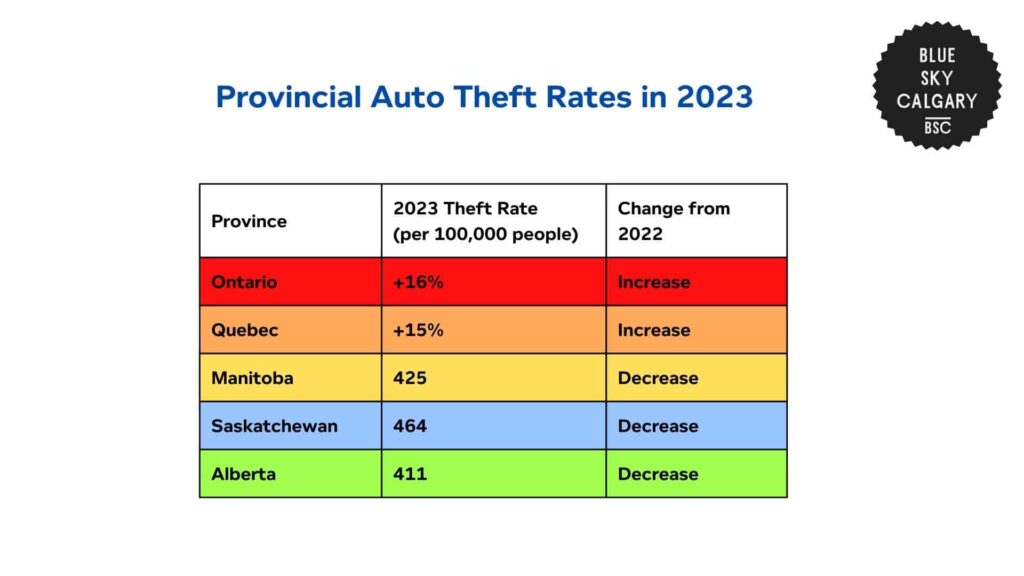
Car Theft Claim Expense Trends in Calgary
The Insurance Bureau of Canada illustrates how auto theft claims expenses have increased exponentially throughout Alberta, with Calgary being one of the hardest-hit cities.
From 2021 to 2023, Calgary’s auto theft claims rose from $20.86 million to $33.08 million, representing a 59% increase within two years. This rise of almost $12.2 million in auto theft claims expenses is a significant warning for the city’s law enforcement.
Moreover, this growth represents both the increase in stolen cars and the elevated value of vehicles being stolen. This is because criminals target new, high-value models more than ever before.
For example, since luxury SUVs and pickup trucks, which have a higher resell value, were among the most frequently stolen vehicles, this further contributed to the rising costs of auto theft claims.
As for other cities in the region, Edmonton had the highest overall cost of claims, growing from $15.75 million in 2021 to $26.19 million in 2023, an increase of 66%.
Meanwhile, Medicine Hat posted the most dramatic percentage jump, with claims jumping by 72%, though its overall cost remains lower at $672,398 in 2023.
Frot McMurray and Lethbridge also rose 60% and 30%, respectively, capturing a more widespread provincial pattern of increasing auto theft-related loss.
| City | 2021 Claims Cost | 2022 Claims Cost | 2023 Claims Cost | Increase (2021-2023) |
| Calgary | $20,856,769 | $29,040,163 | $33,076,848 | 59% |
| Edmonton | $15,749,461 | $21,224,044 | $26,193,922 | 66% |
| Medicine Hat | $390,761 | $427,586 | $672,398 | 72% |
| Fort McMurray | $2,071,849 | $2,441,559 | $3,311,123 | 60% |
| Lethbridge | $732,742 | $1,167,920 | $955,716 | 30% |
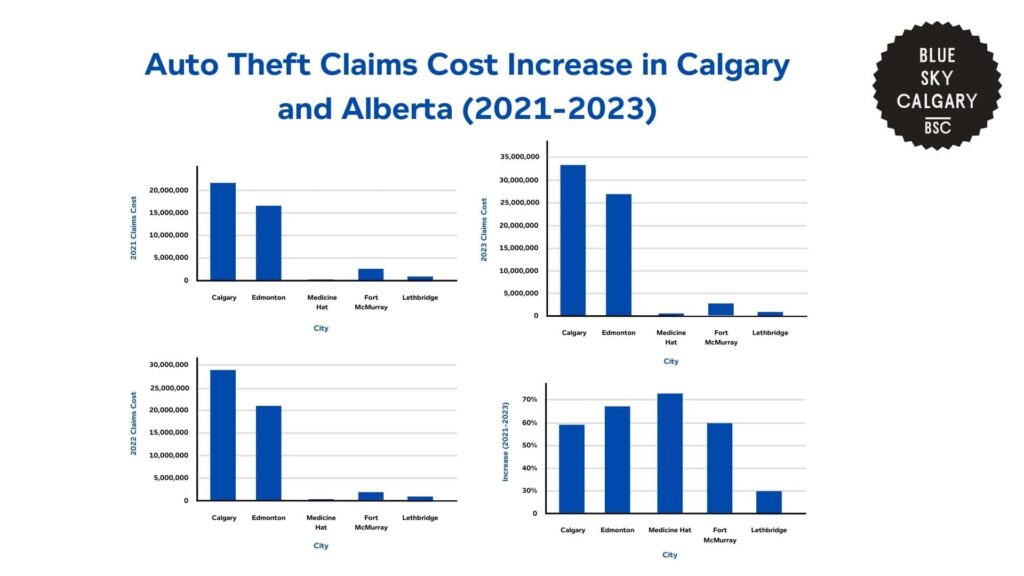
The Youth as the Most Vulnerable to Car Theft
Statistics Canada reports that motor vehicle theft is a large part of Canadian household victimization.
Motor vehicle or motor vehicle part theft in 2019 was reported 20 times per 1,000 households, which is less frequent than household property theft (65 per 1,000) or vandalism (45 per 1,000).
However, this was still a major contributor to the 2.6 million reported household victimizations for that year, which accounted for 32% of all reported criminal occurrences.
Younger Canadians are disproportionately victimized by property crime, including auto theft.
For example, self-reported victimization from the General Social Survey (GSS) on Victimization indicates that the 15 to 24 age group had the highest rate of overall victimization.
The total number of reports from this age group was 176 incidents per 1,000 population. This was followed by the 25 to 34 age group, at 135 incidents per 1,000.
Victim rates, however, decrease substantially among those 35 years and older, with rates falling below 100 occurrences per 1,000 population.
Thus, this indicates that the younger population is more prone to being victims of theft offenses, such as motor vehicle theft.
This is based on such factors as increased use of personal transportation, increased use of high-risk parking sites, and decreased availability of secure storage for vehicles.
| Age Group | Victimization Rate (per 1,000 people) |
| 15–19 | 176 |
| 20–24 | 176 |
| 25–29 | 135 |
| 30–34 | 135 |
| 35–39 | <100 |
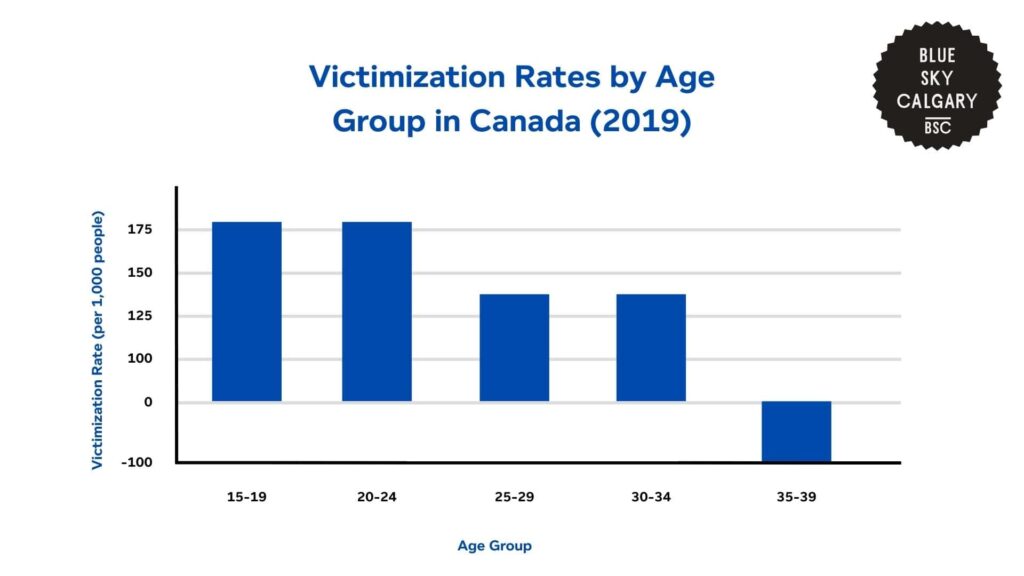
Costs and Consequences of Car Theft
The Insurance Bureau of Canada reports that auto theft has caused heavy financial losses to both consumers and insurers. Private auto insurers in Canada settled $1.5 billion of theft claims in 2023 alone, up from a 254% increase since 2018.
This increase in theft claims has consequently led to rising insurance premiums, with comprehensive auto insurance rates jumping between 25% and 50% over the last two years.
Moreover, the Financial Post illustrates how this increasing economic burden is especially seen in Alberta and Ontario, where high rates of automobile theft have translated to significant economic losses for motorists.
In Calgary, automobile theft claims expenses increased by 59% between 2021 and 2023, from $20.86 million to $33.08 million.
This spike is consistent with the province-wide trend since Edmonton’s theft claims increased by 66%, and Medicine Hat witnessed a rise of 72%, the highest among Alberta cities.
Such rising costs indicate that although, in 2023, Alberta’s theft rate dropped marginally, the financial impact is severe due to the rising value of stolen vehicles as well as increasing insurance claims.
The increasing expense of auto theft is also impacting individual motorists. Auto theft in Ontario costs each driver an estimated $130 per year, and Alberta is probably bearing a similar financial burden.
Insurers have also added a $500 surcharge on high-risk vehicles such as the Honda CR-V, Ford F-Series, and Dodge Ram 1500, which are some of the most stolen vehicles in Canada.
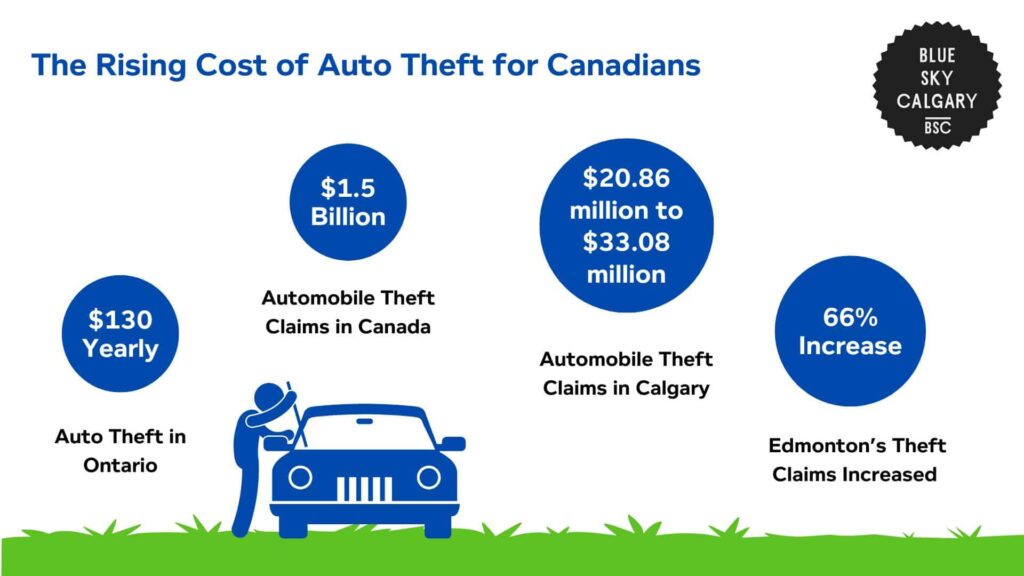
Interventions and Solutions to Car Theft in Canada
In response to the rising number of auto theft cases in Canada, the federal government initiated the National Action Plan on Combatting Auto Theft in 2024.
This will be aimed at dismantling the organized crime rings that are responsible for vehicle theft while also enhancing law enforcement capacity to address the growing crisis.
One of the major features of the plan centers on intelligence and sharing of information among federal, provincial, territorial, and international levels of government.
By increasing data sharing and cooperation, authorities are in a position to trace stolen vehicles more effectively as well as pinpoint criminal groups dealing in vehicle theft.
Another major step in the action plan is the intervention mechanisms to prevent stolen cars from being exported.
The Canada Border Services Agency (CBSA) was allocated a $28 million investment in order to increase its capability of detecting and searching shipping containers of suspected stolen cars.
This funding also facilitates greater collaboration with foreign agencies to intercept stolen vehicles prior to their departure from Canadian ports.
Moreover, proposed legislative and regulatory reforms aim to enhance penalties for organized crime groups involved in auto theft.
More recent initiatives have already yielded positive results. In January 2024, 251 stolen vehicles were seized at an Italian port in a joint operation involving the Royal Canadian Mounted Police (RCMP) and the Italian police.
Likewise, in April 2024, close to 600 stolen vehicles were confiscated from the Port of Montreal as a result of an extensive partnership between the CBSA and the Ontario and Quebec police forces.
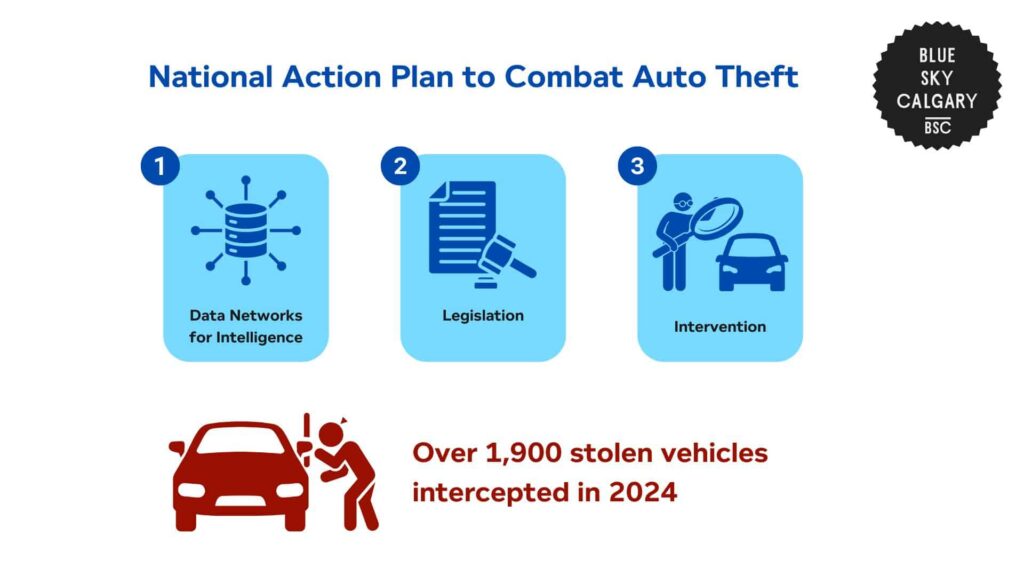
Car Theft Projections and Future Trends
Auto theft in Canada is likely to continue to be a major issue over the next few years.
Current forecasts include a steady increase in high-value vehicle thefts, further expansion in organized crime involvement, and increasing financial losses to consumers and insurers.
Despite more recent efforts from law enforcement and more new legislation to hamper car theft, statistics indicate that the level of sophistication used in auto theft strategies, such as VIN fraud and keyless entry hacking, will only improve further.
Moreover, vehicle theft claims have already increased by 59% in Calgary between 2021 and 2023, which is a pattern that may hold if recovery rates keep going down.
At the national level, the Insurance Bureau of Canada is cautioning that automobile theft claims, which hit $1.5 billion in 2023, could continue to rise if current theft rates continue.
If theft levels do not reduce, insurance premiums, which are already climbing between 25% and 50% in some areas, are certain to rise further. This will continue to add to the financial pressure put on car owners.
Therefore, the long-term success of current initiatives to combat car theft will depend on ongoing cooperation among law enforcement, insurers, and motor vehicle manufacturers in creating more robust theft-deterrent systems.
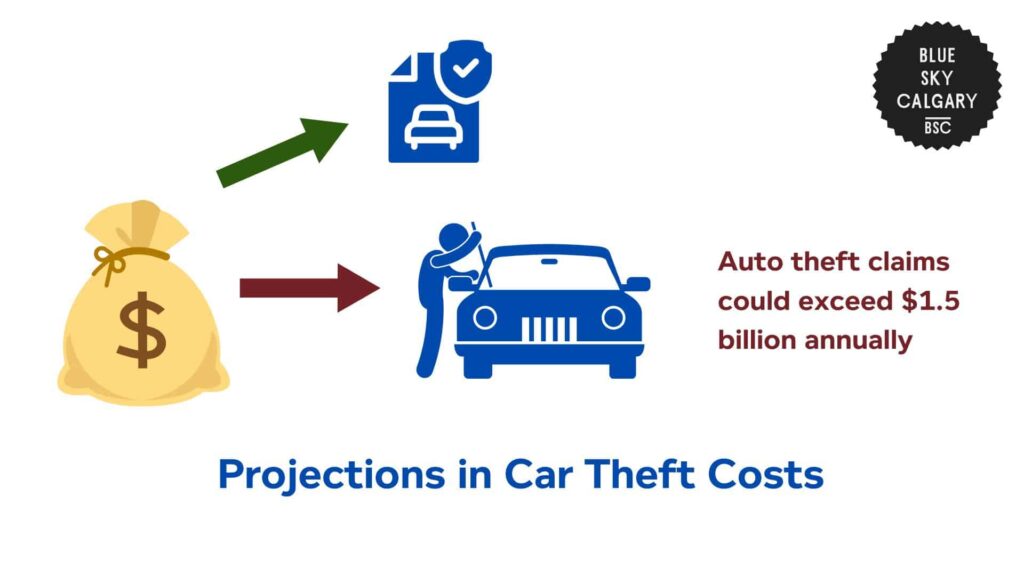
References
- Canada Border Services Agency. (n.d.). Seizures and security measures. Government of Canada. Retrieved from https://www.cbsa-asfc.gc.ca/security-securite/seizure-saisie-eng.html
- CTV News. (n.d.). As number of auto thefts drops nationally, Alberta logs highest per capita theft rate. Retrieved from https://www.ctvnews.ca/canada/article/as-number-of-auto-thefts-drops-nationally-alberta-logs-highest-per-capita-theft-rate/
- Équité Association. (n.d.). Top 10 most stolen vehicles in Canada. Retrieved from https://www.equiteassociation.com/top-10-most-stolen-vehicles
- Équité Association. (2023). First half of 2023 auto theft trend report. Retrieved from https://assets.website-files.com/614f811f9a079b223c5d23ab/651bbce6b7a633cd6b7e6120_Equite%20Association%20-%20First%20Half%20of%202023%20Auto%20Theft%20Trend%20Report%20-%20EN.pdf
- Financial Post. (n.d.). Auto theft in Canada is costing you big money. Retrieved from https://financialpost.com/news/auto-theft-canada-costing-you-big-money
- Government of Canada. (2024, February). Government of Canada hosts national summit on combatting auto theft. Public Safety Canada. Retrieved from https://www.canada.ca/en/public-safety-canada/news/2024/02/government-of-canada-hosts-national-summit-on-combatting-auto-theft.html
- Insurance Bureau of Canada. (n.d.). End auto theft: Theft prevention strategies. Retrieved from https://www.ibc.ca/stay-protected/theft-prevention/end-auto-theft
- Insurance Bureau of Canada. (n.d.). Top 5 hot spots in Alberta for auto theft claims. Retrieved from https://www.ibc.ca/news-insights/news/insurance-bureau-of-canada-reveals-the-top-5-hot-spots-in-alberta-for-auto-theft-claims
- Public Safety Canada. (n.d.). National action plan on combatting auto theft. Retrieved from https://www.publicsafety.gc.ca/cnt/cntrng-crm/autothft-cntrvhcls/ctn-pln-en.aspx
- Statistics Canada. (2021). Police-reported crime statistics in Canada, 2020. Juristat, 85-002-X. Retrieved from https://www150.statcan.gc.ca/n1/pub/85-002-x/2021001/article/00014-eng.htm
- Statistics Canada. (2024, July 25). Trends in police-reported motor vehicle thefts in Canada, 2023. The Daily. Retrieved from https://www150.statcan.gc.ca/n1/daily-quotidien/240725/dq240725b-eng.htm

